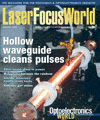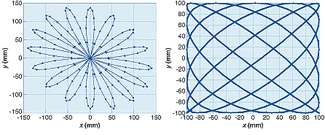 |
||
|

| QUICK VOTE | ||||
|
|
||||
| NEW FROM LASER FOCUS WORLD | ||||
| Webcast Archive: Optical Fiber Solutions presents "Laser Optimized Multimode Fibers" from KMI Research's Newport Conference Dovebid Equipment Auctions Try our new used equipment auctions! Powered by DoveBid 2003 Buyers
Guide Questionnaires |
||||
|
| ||
| Free-space communications struggles to find its niche | ||
|
Free-space optical communications has found a small market in interbuilding links. But to penetrate other areas, tough technical problems must be overcome. | ||
|
by Eric J. Lerner | ||
|
The vast majority of today's optical communications runs through fibers, while the vast majority of free-space wireless communications is transmitted at radio wavelengths. Producers of free-space optical communications have had an uphill battle to find markets that are not better served by either fiber or radio. So far, only a relatively small portion of the market for interbuilding short-distance communication has been penetrated by wireless optical in areas where, for some reason, laying fiber is too expensive. | ||
|
To expand substantially, free-space optical will have to prove itself in larger markets—either the "final mile" for urban users, indoor mobile communications, or for space communications. But in all these areas, free-space faces significant technical challenges that have only begun to be overcome, as well as tough competition from other technologies. | ||
|
Studies at Ben Gurion University indicate that rose (left) and lissajous (right) search patterns are most efficient in finding a satellite communication beam. The interbuilding niche | ||
|
However, optical free-space links are far more affected by the weather than are microwave links. Fog in particular can severely interfere with free-space communications; for high reliability a microwave backup is needed, considerably reducing the advantages of optical links. | ||
|
Into the upper atmosphere | ||
The air-to-air link's laser terminal is mounted in a turret on the underside of a T39-A test aircraft (see Fig. 1). The optical subsystem in the turret consists of a communication and coarse-tracking telescope with array sensors, two beacon lasers, a fine-tracking telescope and sensor, four communications lasers, and a fast-steering mirror, all attached to a composite optical bench. Initial alignment is established by transmitting the Global Positioning system positions of the two aircraft to each other by radio. This allows the coarse-tracking telescope to lock onto the broad coarse-tracking beacon. The fine-tracking telescope then locates and locks on the fine-tracking beacon, keeping the very fine communications laser beam within 12 μrad of the communications receiver. The four lasers combine to form two channels, each with a 600-Mbit/s data rate and a 200-mW output. Flight testing of the system will be carried out throughout this year. | ||
|
Easing into space | ||
|
The first telecommunications satellite to use free-space lasers, Artemis, is now in orbit after barely escaping disaster. The European Space Agency satellite was launched by an Ariane 5 rocket in July 2001 but failed to reach a proper orbit as a result of a rocket malfunction. Fortunately, the satellite's new ion rocket, originally designed to keep it in place in geosynchronous orbit, came to the rescue and was ordered to boost the satellite up to geosynchronous. | ||
|
Artemis is now linked to another satellite, the Earth Observation Satellite Spot 4, over a 60-mW laser operating in the 800- to 850-nm band with a 50-Mbit/s capacity. The beam width of only a few microradians makes accurate pointing and tracking essential. | ||
|
Inner space | ||
|
However, indoor wireless optical communications based on infrared emitters and sensors has advantages. It has a much larger bandwidth (important for downloading video data), it is immune to electromagnetic interference, and it offers better security because it cannot pass through walls. So far, these advantages have not been enough to overcome the big Bluetooth lead. | ||
|
To further open the bandwidth gap between optical and radio-frequency (RF) indoor systems, engineers are developing new modulation schemes that more efficiently use the available bandwidth. For example, pulse-interval modulation encodes information in the length of interval between a short-duration pulse at the beginning of each frame and subsequent information-carrying pulses.4 These new schemes can substantially reduce the power required for a given signal-to-noise ratio and information-carrying capacity. | ||
|
One of the key disadvantages of optical free-space links compared with RF—even in an indoor environment—is that optical links are line-of-sight and bidirectional while RF links offer one-to-many or many-to-many and are omnidirectional. To avoid this problem, engineers have been developing quasi-diffuse links. Instead of transmitting a single beam, transmitters emit multiple narrow beams that illuminate small areas, or diffusing spots, on a diffuse reflecting surface such as a wall or ceiling. Receivers also have many elements to receive from more than one diffusing spot, so that communication is uninterrupted even if some of the transmitter beams are blocked by, for example, someone walking in front of them.5 | ||
|
Multiple diffuse links create multipath distortion, because there are several paths of different lengths for signals to get from transmitter to receiver. One way to minimize this problem, which can degrade signals, is to ensure that the diffusion spot pattern is matched to the receiver field of view in such a way that only one spot is within each field of view (see Fig. 2). | ||
|
FIGURE 2. Creating many diffuse spots (small dots) on a wall or ceiling can prevent free-space communications in a building from being interrupted. To avoid the problem of multipath distortion from many spots, the field of view of individual receiver branches (large circles) can be adjusted for that; at most one diffusion spot lies within each field of view (right). In brightly lit offices, background optical noise is also a problem. Receivers for optical communications need narrow spectral filters and optical concentration to achieve good signal-to-noise ratios. One approach to this problem is to use a holographic optical element for both filtering and light concentration. A holographic mirror will act as a spherical mirror to concentrate the light and will only reflect to the detector a narrow spectral range. Such concentrators can improve signal-to-noise ratios by up to 18.5 dB, allowing the use of bandwidths up to 2 GHz. | ||
|
The commercial future of free-space optical communications remains uncertain. On the one hand, the push for ever-greater bandwidth could eventually outrun any RF capacity, forcing a shift to free-space optical. On the other, RF techniques have a long head start in inside-building applications, and the weather problem remains a severe one for optical interbuilding links. Perhaps the best overall prospects are in space, where progress is being made in improving acquisition and tracking. Once these are perfected, the bandwidth advantages of optical free-space communications should open up a substantial market niche. | ||
|
REFERENCES | ||
|
2. J. Petrovich et al, SPIE 4214, 14 (July 2001). | ||
|
3. N. S. K. Sheinfield and S. Arnon, SPIE 4365, 195 (September 2001). | ||
|
4. N. M. Aldibbiat et al, SPIE 4214, 144 (July 2001). | ||
|
5. S. Jivkova and M. Kavehrad, SPIE 4214, 162 (July 2001). | ||
|
EDITOR'S NOTE: Optical communications is the subject of this month's "Focus On . . ." series. In addition to this article on free-space communications, several other features address different aspects of communications: "Optical Networking" discusses optical packet switching on page 131, a look at erbium-doped waveguide amplifiers is on page 101, and optical performance monitoring is covered on page 149 . | ||
| Laser Focus World June, 2002 Author(s) : Eric Lerner | ||
| CURRENT ISSUE | ||
|
August 2002  |
||
| PRODUCT GUIDE | ||||
| FEATURED COMPANIES | ||||
Advanced Photonix Inc Spectra-Physics Semiconductor Lasers Fermionics Opto-Technology Lightwave Electronics Product Guide Main Menu |
||||







